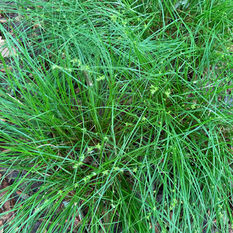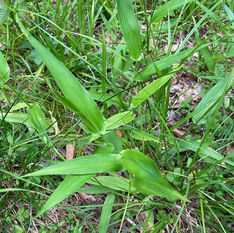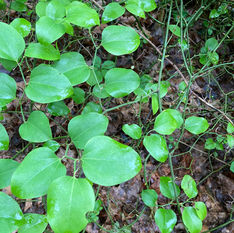top of page
WAVENY DISC GOLF
Course Flora
Herbaceous Wildflowers

Common Blue Violet (Viola sororia)
Native to rich, moist woods, and swamps located in the eastern half of the United States and Canada. They bloom in April-August. Flowers can be white, blue or purple.

Carolina Spring Beauty (Claytonia caroliniana)
A small, forest floor, flowering plant, native to the Appalachian Mountains and piedmont. It blooms in the woods in the Course in mid-April.

Fig Buttercup aka Lesser Celandine (Ficaria verna)

Snowdrop (Galanthus nivalis)
Native to Europe, but found in eastern North America. An early bloomer. One was found blooming on Hole 11 in March.

Wild Geranium (Geranium maculatum)
Native to woodland in eastern North America.

Yellow Trout Lilly (Erythronium americanum)
Erythronium americanum, the trout lily, yellow trout lily, fawn lily, yellow adder's-tongue, or yellow dogtooth violet, is a species of perennial, colony forming, spring ephemeral flower native to North America and dwelling in woodland habitats. Within its range it is a very common and widespread species, especially in eastern North America. The common name "trout lily" refers to the appearance of its gray-green leaves mottled with brown or gray, which allegedly resemble the coloring of brook trout.

Bloodroot (Sanguinaria canadensis)
Bloodroot is native to eastern North America from Nova Scotia to Florida, and west to the Great Lakes and down the Mississippi embayment. Sanguinaria canadensis grows in moist to dry woods and thickets, often on floodplains and near shores or streams on slopes. They grow less frequently in clearings and meadows or on dunes, and are rarely found in disturbed sites.

Dame's Rocket (Hesperis matronalis)
Dame’s Rocket is a flowering biennial or perennial that grows up to 3 feet high. Its showy, bisymmetric flowers bloom in May and June and range from purple and pink to white and have four petals. Dame’s Rocket is a habitat generalist and will grow in moist woodlands, woodland edges, roadsides, thickets, disturbed sites, and open ground. It prefers moist and mesic non-acidic soils and partial sun. Native to southern Europe from Spain to Turkey, Dame's Rocket was brought to North America in the 17th century and has since become naturalized there, now growing throughout most of the US and Canada. n Connecticut, it is classified as invasive.

False Hellebore (Veratrum viride)
Veratrum viride, known as Indian poke, corn-lily, Indian hellebore, false hellebore, green false hellebore, or giant false-helleborine, is a species of Veratrum native to eastern and western (but not central) North America. It is found in wet soils in meadows, sunny streambanks, and open forests. It is extremely toxic, and is considered a pest plant by farmers with livestock.

Skunk Cabbage (Symplocarpus foetidus)
Symplocarpus foetidus, commonly known as skunk cabbage or eastern skunk cabbage (also swamp cabbage, clumpfoot cabbage, or meadow cabbage, foetid pothos or polecat weed), is a low-growing plant that grows in wetlands and moist hill slopes of eastern North America. Bruised leaves present an odor reminiscent of skunk.

Greater Burdock (Arctium lappa)
Arctium lappa, commonly called greater burdock, gobō, edible burdock, lappa, beggar's buttons, thorny burr, or happy major, is a Eurasian species of plants in the family Asteraceae, cultivated in gardens for its root used as a vegetable. It has become an invasive weed of high-nitrogen soils in North America, Australia, and other regions.

Mugwort (Artemisia vulgaris)
Artemisia vulgaris, commonly known as mugwort, common mugwort, or wormwood, is a species of flowering plant in the daisy family Asteraceae. Mugworts have been used medicinally and as culinary herbs. Artemisia vulgaris is native to temperate Europe, Asia, North Africa, and Alaska, and is naturalized in North America, where some consider it an invasive weed. It is a common plant growing in places containing low-nitrogen soils, such as waste places, roadsides and uncultivated areas.

Common Cinquefoil (Potentilla simplex)
Potentilla simplex, also known as common cinquefoil or old-field five-fingers or oldfield cinquefoil, is a perennial herb in the Rosaceae (rose) family native to eastern North America from Ontario, Quebec, and Labrador south to Texas, Alabama, and panhandle Florida. It is commonly found in woodlands, fields, and disturbed areas.
Grasses

Eastern Star Sedge (Carex radiata)
Eastern star sedge, scientifically known as Carex radiata, is a low-growing, clump-forming sedge native to central and eastern North America. It's characterized by its narrow, grass-like leaves and star-shaped flowering structures, earning it the name "eastern star sedge". This sedge thrives in moist to mesic soils and partial shade to full shade.

Deertongue (Dichanthelium clandestinum)
Dichanthelium clandestinum, commonly called deer tongue, is a species of grass native to eastern North America, including eastern Canada and the eastern United States. It is a species of rhizomatous perennial grass, forming clumps of hairy stems up to 1.4 meters tall.

Gray's Sedge (Carex grayi)
Carex grayi, commonly known as Gray's sedge, is a species of flowering plant in the sedge family, Cyperaceae. It is native to eastern North America. It grows to 3 feet high.
Vines

Virginia Creeper (Parthenocissus quinquefolia)
Virginia creeper is a species of flowering vine in the grape family. It is native to eastern and central North America, from southeastern Canada and the eastern United States west to Manitoba and Utah, and south to eastern Mexico and Guatemala. A woody, dedicuous vine, Virginia Creeper can be high-climbing or trailing, 3-40 ft.; the structure on which it climbs is the limiting factor. Virginia Creeper climbs by means of tendrils with discs that fasten onto bark or rock. Its leaves, with 5 leaflets, provide early fall color, turning brilliant mauve, red and purple. Inconspicuous flowers small, greenish, in clusters, appearing in spring. Fruit bluish, about 1/4 inch in diameter. A vigorous grower, it tolerates most soils and climatic conditions. Although it is sometimes mistaken for poison ivy (which has 3 leaves, while Virginia Creeper has 5), Virginia Creeper does not cause skin rashes like poison ivy does.

Common Greenbrier (Smilax rotundifolia
Common greenbrier is a woody vine native to the southeastern and eastern United States and eastern Canada. It is a common part of the natural forest ecosystems in much of its native range. The leaves are glossy green, petioled, alternate, and circular to heart-shaped. They are generally 5–13 cm long. Common greenbrier climbs other plants using green tendrils growing out of the petioles. The stems are rounded and green and are armed with sharp thorns. The flowers are greenish white, and are produced from April to August. The fruit is a bluish black berry that ripens in September.

Eastern Posion Ivy (Toxicodendron radicans)
Toxicodendron radicans, commonly known as eastern poison ivy or poison ivy, is a species of allergenic flowering plant. The species is found in North America. Although commonly eaten by animals, with birds consuming the seeds, T. radicans is considered a noxious weed, due to the fact that it causes urushiol-induced contact dermatitis in most people who touch it. Although typically found in areas with with partial shade and well-drained soils, eastern poison ivy thrives in a wide variety of habitats. It can grow as a ground vine, climbing vine, or a shrub.
Bushes

Japanese Barberry (Berberis thunbergii)
Berberis thunbergii, the Japanese barberry, Thunberg's barberry, or red barberry, is a species of flowering plant in the barberry family Berberidaceae, native to Japan and eastern Asia, though widely naturalized in China and North America, where it has become a problematic invasive in many places, leading to declines in species diversity, increased tick habitat, and soil changes. Growing to 1 m (3 ft 3 in) tall by 2.5 m (8 ft 2 in) broad, it is a small deciduous shrub with green leaves turning red in the autumn, brilliant red fruits in autumn and pale yellow flowers in spring.

Multiflora Rose (Rosa multiflora)
Multiflora rose is an invasive perennial shrub native to China, Japan, and Korea. It is a thorny, thicket-forming shrub with broad, arching, climbing canes and stiff, curved thorns. It can reach 10-15’ tall and 9-13’ wide. Multiflora rose (Rosa multiflora) thrives in a wide range of habitats, often colonizing disturbed areas like roadsides, fields, and pastures. It can also be found in woodlands, forest edges, and even dense forests where canopy gaps occur.

Japanese Wineberry (Rubus phoenicolasius)
Rubus phoenicolasius (Japanese wineberry, wine raspberry, wineberry or dewberry) is an invasive Asian species of raspberry native to China, Japan, and Korea. Wineberries grow vigorously and can form extensive, dense thickets that displace many native species. Wineberries can be found in many habitats, such as forest, fields, stream banks, and wetland edges, as well as open woods. The fruit of the plant is edible, sweet and tart with a raspberry-like flavor.
Ferns

Sensitive Fern (Onoclea sensibilis)
Onoclea sensibilis, the sensitive fern, also known as the bead fern, is a coarse-textured, medium to large-sized deciduous perennial fern. The name comes from its sensitivity to frost, the fronds dying quickly when first touched by it. Onoclea sensibilis is native to Northern Hemisphere temperate regions; the Russian Far East, China and Eastern Asia, and a wide native distribution in Northern America. Onoclea sensibilis grows best in moist shaded or partially shaded areas, dwelling in a variety of swamp and wood habitats: wet meadows, thickets and bogs, as well as stream and riverbanks and roadside ditches.

Common Male Fern (Dryopteris filix-mas)
Dryopteris filix-mas, the male fern, is a common fern of the temperate Northern Hemisphere, native to much of Europe, Asia, and North America. It favours damp shaded areas in the understory of woodlands, but also shady places on hedge-banks, and rocks, and screes.
bottom of page